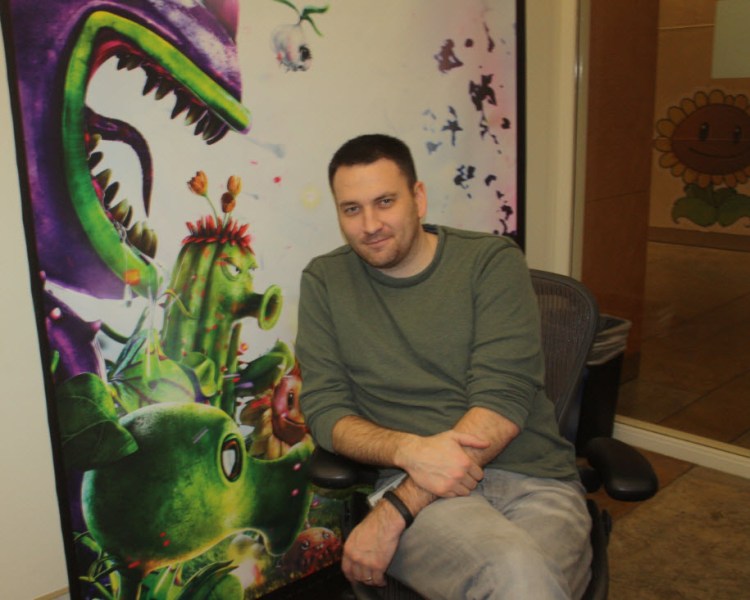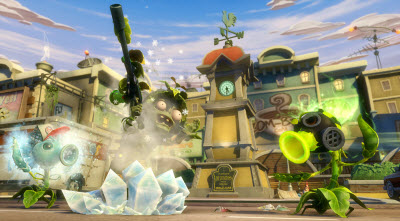It’s about time we got a funny shooter. We spent some time this week with Electronic Arts’ PopCap Games to play a demo of the multiplayer-only Plants vs. Zombies: Garden Warfare shooter coming Feb. 18 on the Xbox One and Xbox 360 consoles. The game is a satire of Call of Duty: Modern Warfare, and it’s loaded with humor. The close combat game pits plants, who are more stationary and defensive, against the offensive but slow and dim-witted zombies.
The fun isn’t its realistic first-person shooter combat. It’s in the goofy characters and the zany customized weapons that they can use against each other. It’s a lot more like Valve’s Team Fortress 2 team shooter than anything, particularly since the battle arenas are smaller in size. We interviewed Garden Warfare producer Brian Lindley. He told us the priorities were humor, accessibility, and depth. Here’s an edited transcript of the interview.
GamesBeat: How have you honed things since E3? Have you changed much?
Brian Lindley: We’ve iterated a ton on the characters and the balance of the gameplay. From June until now is a lot of time. We’ve continued to build up the content and the customization. Our focus has been getting the foundation of the gameplay solid, that balance between the core classes. Now we’re investing a lot in customization and getting that ready for launch.
GB: The customizations seem like they can stretch the number of character choices that you have.
Lindley: Absolutely. Each class is going to have five different costumes or so. Those costumes are going to make some changes to their weapons and their abilities. Not so they feel like a completely different class, but just some slight variations to how you play.
GB: How are you constructing the maps? They all seem very close-range.
Lindley: In what we played today, Team Vanquish, the maps are a bit smaller in scale. It’s more of an arena style in that game mode. We also have maps that are much larger in scale for our other multiplayer mode, Gardens and Graveyards. That one has multiple bases – seven, eight huge bases and landmarks that the plants and the zombies are fighting to control.
The third mode is the four-player online co-op mode where you play as the plants. That’s going to take place in levels about the size of what you played today. We’ll have different base configurations in those, where you’re setting up and trying to survive against the zombies.
GB: How did you hone in on these three major ways to play, and the characters you decided to use?
Lindley: Through a lot of trial-and-error to start. The game modes have been kind of easy for us, because they’re the standard modes you expect in this type of game. We definitely focused first on Gardens and Graveyards, because we felt it was spiritually the closest to the tower defense game, where you’ve got plants hunkered down trying to defend the location, using potted plants to fortify their position, and the zombies on the attack to take that down. We see that mode as the spiritual extension of the original game, but realized in a multiplayer setting. The four-player co-op is similar, where you’re playing as the plants and trying to survive against the waves of zombies.
With the characters themselves, the plants were straightforward for us. We had characters existing in the original game that matched nicely to existing shooter archetypes. The Pea Shooter just makes sense as an infantry-style character. The Sunflower makes sense as a healer, Cactus as a sniper, and so on.
The zombies were a big challenge, though. A lot of the zombies in the original game are one-dimensional. They have their one trick, and that’s all they do. We had to give them more to do, just so they feel like complete characters with well-rounded abilities. That’s where we spent a lot of time, figuring out what designs and professions make sense for these guys. How do we make them feel familiar, yet new and funny and kind of dumb, like you’d expect zombies to be? We spent a ton of time iterating on that.
GB: So you started with the notion that plants should be smarter than zombies?
Lindley: [Laughs] It’s kind of one of the foundations of the universe. The core conceit is that the zombies are dumb and fumbling and just trying to get to the brains. The plants are the heroes trying to defend. In that sense, they’re a little bit smarter. But they’re still plants, after all.
GB: You probably had a lot of different possibilities. Did you think about things like vehicles?
Lindley: Yeah, absolutely. When we were initially prototyping, we tried a lot of different things, different varieties of characters and abilities. What we started coming back to is, how do we make this have depth, but still have some accessibility to it? Don’t overcomplicate things too much. That set us down the path of making sure that all the characters have a standard layout of abilities, and those are as easy to understand as we can make them.
When you start talking about jeeps and tanks and God knows what, it really balloons the scope and the size of the levels you need to build. They’re great features for a game to have, especially a multiplayer game, but we wanted to focus first on that character gameplay before we started broadening to vehicles and even bigger things.
GB: The controller has more buttons than you have things to assign to those buttons, right?
Lindley: We definitely have some buttons left to do things with if we wanted to, but I think it just comes down to us making sure that the controls for each of the characters are as consistent as possible. We use the face buttons and the bumpers quite a bit for ability activation, but we don’t necessarily have abilities mapped to every single potential input on the controller. That just adds things that you need to teach. It’s depth in some respects, but it also creates complications for players trying to pick up and learn the game.
GB: How does the game differ from something like Battlefield in terms of distance and scale? The sniper looks like they’re shooting about 100 feet away. How is that different to design?
Lindley: It’s a little bit different just in terms of scale. The levels in Battlefield are obviously a bit larger than what we’re going to have here. The sniper classes definitely don’t have the same range you’d see there. Because the characters are so key to the experience, we didn’t want to have that huge distance and keep things sparse. We wanted to keep players playing as a team around each other. A lot of our maps and abilities are designed around that kind of team concept. You’re not just sitting on your own in a corner of the map all the time, waiting to see somebody. We’d rather keep the players closer together, fighting it out.
GB: I can imagine that you could do something like hand-to-hand fighting as well.
Lindley: We could go in some crazy directions and do things like melee, yeah. But at the core of this game, it’s a shooter. It’s about using your weapon and taking out the enemy with what you’ve got.
GB: You have some cute humor in there, like the engineer’s butt crack.
Lindley: Yeah, that’s one of my favorites.
GB: What kind of priority did you give to fitting that into the game?
Lindley: When we think about Plants vs. Zombies, there are attributes that are universal. Humor is at the top of the list. Accessibility is another one. Depth is another one. These are the things that carry forward in any Plants vs. Zombies game you’re going to play. Making sure the characters have that charm and that humor is core to the design. If we put something in the game and it doesn’t make you smile, make you laugh, or even seem funny at a glance, we have to think hard if that’s something that makes sense in this world.
VentureBeat's mission is to be a digital town square for technical decision-makers to gain knowledge about transformative enterprise technology and transact. Learn More





